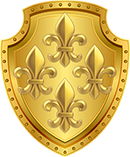
SYMBOLS
The coat of arms of the Order of the Jerusalem Cross; one of the main symbols along with the flag and the anthem. The coat of arms description: Black eagle with a gold beak and paws, wings lowered down. The right wing depicts the coats of arms of the Kingdom of Jerusalem and the Principality of Antioch, the left wing depicts the coats of arms of the County of Edessa and the County of Tripoli. This is how the Order honors the memory of the Crusader states of the Holy Land. In the eagle’s right paw — a silver sword with a gold hilt (symbol of the knightly valor), in the left – a golden torch (a symbol of readiness for self-sacrifice). On the chest is a red shield with a black Jerusalem Cross and a narrow white border around the edge of the cross. The shield is topped with a golden noble crown. Around the shield is a collar of the Order of the Jerusalem Cross. The eagle’s tail is covered with a red ribbon with a gold inscription of the motto: «DEUS VULT» — the battle cry of the Crusaders of the First Crusade (1099). The eagle is located on the red ermine mantle with a gold fringe, topped with a silver royal crown (symbol of the Order’s independence).
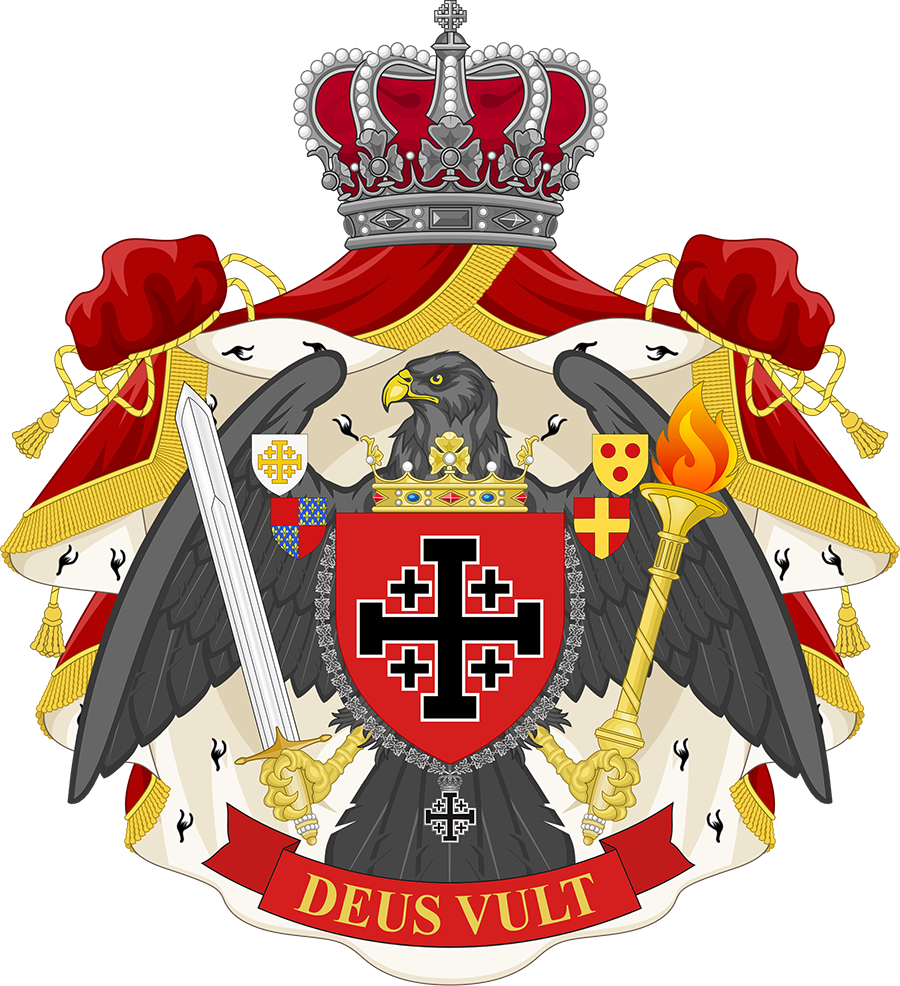
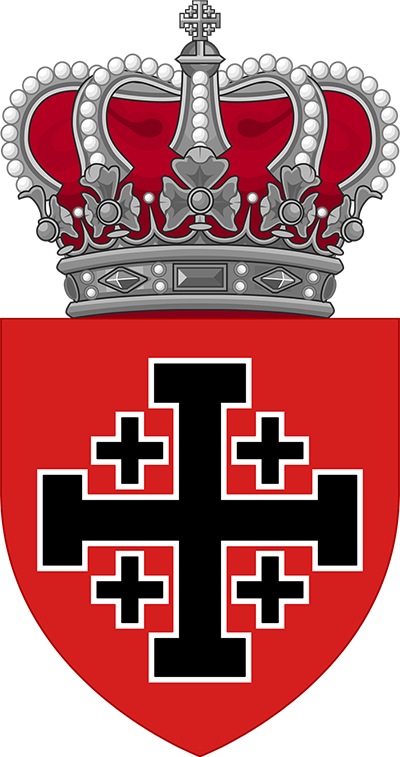
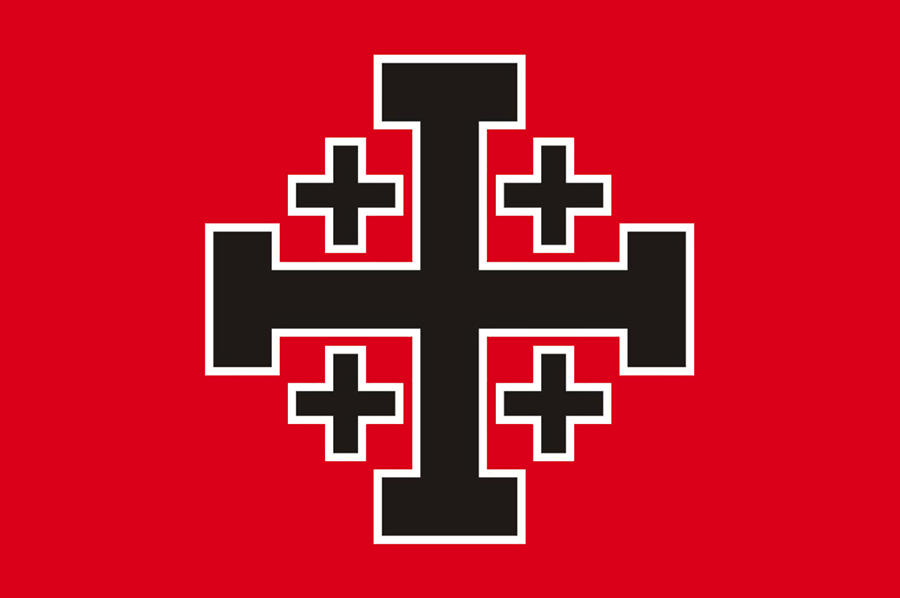

The Cross is an ancient solar symbol dedicated to the sun and fire. When people learned how to make fire, this discovery was an event of the greatest importance and became a salvation for humanity. It made an indelible impression on the ancient people, and the simple tool with which the fire was kindled (the friction of two wooden bars arranged crosswise) was considered sacred. The worship of fire as a powerful element in ancient times took place among all the peoples of the Earth. The fire warmed, gave hot food, scared away wild animals, dispersed the darkness. The cross is also a symbol of choosing a path, a road; a symbol of the intersection of two opposites, their merging at the intersection.
The Jerusalem Cross (the Crusader’s Cross) consists of five golden crosses on a silver background. It is believed that the cross was approved as the coat of arms of the Kingdom of Jerusalem by Count Godfrey of Bouillon. In late medieval heraldry the Crusader’s cross was used for various Crusader states.
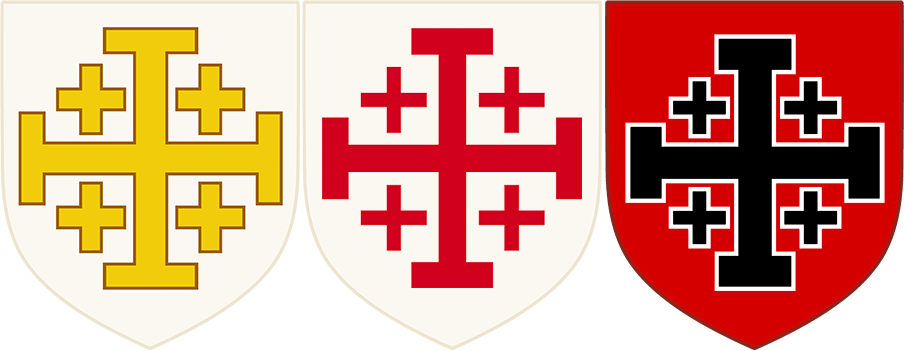
The red Jerusalem cross on a white shield is the coat of arms of the Order of the Holy Sepulchre (Roman Catholic Church). The Order’s activities are aimed at helping the Church, preserving and spreading the faith in the Middle East, attracting Catholics from all over the world to participate in this, as well as protecting the rights of the Church in the Holy Land.
The Jerusalem Cross of our Order is black with a white border around the edge, located on a red shield. These colors symbolize: black – self–denial, white — purity of thoughts, red – sacrificial blood. The Jerusalem Cross is a cultural heritage of humanity and does not have a specific owner. The color scheme of the Cross of our Order is unique and is not used by anyone except us.

The day of the liberation of Jerusalem by the troops of the 1st Crusade on July 15, 1099 is the day of the main order holiday. How it was?
On June 7, 1099, an army of crusaders, numbering about fifteen thousand infantry and up to one and a half thousand spears (both knights and just mounted warriors), approached Jerusalem, the garrison of which consisted of (approximately) a thousand professional Egyptian soldiers and several tens of thousands of armed Muslim townspeople. The walls of the city, reaching eighteen meters, its size and the small number of crusader troops made the siege a very difficult undertaking, if not impossible in principle. At any moment, a new Muslim army could come to the rescue of the city, as happened earlier, during the siege of Antioch. The emir of Jerusalem, Iftikar al-Daula, prepared well for the siege: all the wells around the city were destroyed and poisoned, the Christian population was expelled or intimidated, trees were cut down, and everything that could serve as a help during the siege was destroyed.
All this did not give any hope of a proper siege, and the crusaders were not going to conduct it: their quick march to Jerusalem put the army in a difficult position, there were no allies, no reserves, no siege weapons. Therefore, after six days, the first assault began, in which the Christians had only one siege ladder. Of course, he failed, and, as they say, the first warrior to reach the wall lost both hands.
The crusader army suffered, and if the lack of food was somewhat alleviated by the grain delivered from Ramla, then water became a real problem: many died from poisoning or dehydration, according to eyewitnesses, even for big money it was impossible to get really drunk, while it was only about dirty water.
The situation continued to deteriorate, soon the news came that the Genoese squadron had been defeated by the Egyptian fleet … But on the other hand, six surviving ships, with an invaluable cargo — grain and all kinds of materials necessary for preparing the assault, were able to break through to the crusaders in mid-June. At the same time, it became known that a new Egyptian army was coming to the rescue of the city. The crusaders began to prepare for the assault, spending three weeks creating a siege park (towers, stairs, battering rams, catapults).
Hatred, which grew day by day, reached its peak during this siege. Muslims, almost every day, dragged crosses onto the walls and defiantly urinated and spat on them. The Europeans responded by publicly executing prisoners, sometimes using their bodies as catapult stones, and once sending a living Muslim into the city. He collapsed to the ground before reaching the wall and soon died…
When in early July the crusaders marched around the city barefoot, singing psalms with palm branches in their hands, this aroused even greater hatred of the Muslims, who responded with shots and curses. Five days later, the assault began.
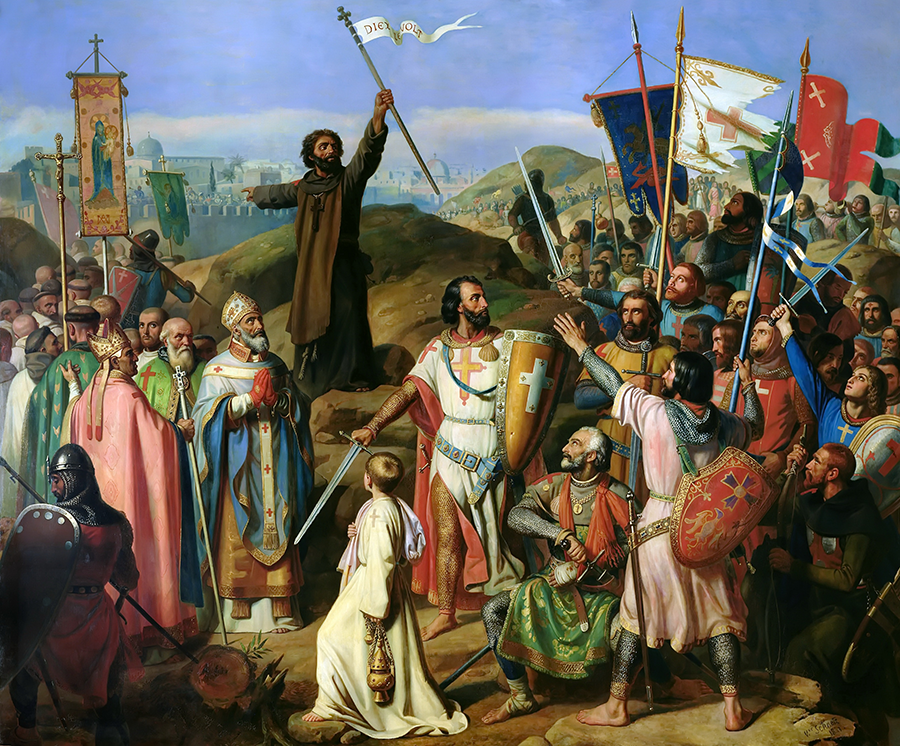
On July 14, 1099, detachments of Europeans went into battle for the liberation of the city sacred to them. As expected, the bombardment of the city walls did little damage, while the Crusaders, moving their siege towers and battering ram, had a much harder time. The assault was preceded by cunning: a few weeks before it began, the crusaders defiantly built a high, at the level of the city walls, a siege tower, opposite the quadrangular city tower in the northwestern part of the city. Seeing this, the Muslims especially fortified themselves there, preparing to repel the attack. However, the tower turned out to be a surprise: on the night before the assault, it was dismantled, like designer parts, and assembled again, in another area: the Saracens were struck like a thunderbolt when they saw the new positions of cars and tents the next morning.
Gottfried of Bouillon, who carried out this maneuver, began the assault by overcoming the first, low wall, in order to then be able to bring his tower to the main wall. To help in this attack was an iron-studded battle ram, which the crusaders dragged to the city under the cover of ballistas and shooters. Soon he broke through the wall and caught fire, set on fire by the defenders. Then it became clear that the battering ram, standing in the gap, was preventing the tower from being brought up and the roles completely changed: the crusaders tried to completely destroy it, and the Muslims tried to put it out by pouring water. The Europeans have won.
Meanwhile, the attack of Raymond of Toulouse and his French failed: the Muslims, who were expecting an attack precisely there, fired so heavily that the attackers could not even really approach the walls. Night has come.
In the morning, Raymond’s soldiers tried to bring the tower down again, but the defenders managed to set fire to it, and it fell apart. Meanwhile, attacks from several directions still forced the Muslims to divide their forces, and Gottfried managed to use this. His men rolled the tower to the main wall and fought a desperate battle. He himself was in the thick of the battle, on the top floor of the tower. The risk was so great that at some point a crusader standing next to him was blown off his head by a shot from a Muslim ballista. The defenders tried to use a secret weapon — they dropped a huge log soaked in a mixture resembling Greek fire on the way to the tower, but the crusaders were ready and extinguished it with vinegar, which they had prepared in advance. The log was removed and the movement continued.
The defenders of the city, emboldened by the hope of the Egyptian army hastening to their aid, doubled the number of darts and stone balls sent by their catapults. With particular stubbornness they sought to destroy the tower of Gottfried, on which a golden cross sparkled. The Duke of Lorraine saw his soldiers and squires fall next to him, but stubbornly moved forward, as if considering himself charmed by arrows and cannonballs. Time passed past noon, and the fate of the battle was still undecided. Many of the attackers began to lose courage, and the enemies immediately noticed this, which they announced with joyful cries. And then, a miracle happened. Suddenly, the crusaders saw a radiant horseman on the Mount of Olives, who, shaking his shield, pointed to Jerusalem. Gottfried and Raimund noticed him first and at the same time exclaimed: «Saint George is coming to our aid!» The sight of the heavenly rider lit the souls of the besiegers with sacred fire, caused them a great upsurge, and the battle unfolded with renewed vigor. Despite all the obstacles, Gottfried’s tower was the first to reach the enemy walls. The Lorraine hero, surrounded by his brothers and vassals, jumped over the drawbridge onto the platform of the wall and crashed into a crowd of terrified enemies. The decisive moment came — the crusaders grabbed the ladders and climbed the wall, the Muslim defense in the northern part of the city completely collapsed. Soldiers following their leader clear the area, descend into the streets and drive the fugitives.
At the same time, the crusaders break down the Kedar gates, and new crowds rush into the city, shouting: “God wants it so! That’s God’s will!» The leaders of the crusaders meet in the square of the fallen Jerusalem; they embrace, cry for joy and rush on to complete their victory. Jerusalem was taken on Friday, July 15, 1099, at three o’clock in the afternoon.
